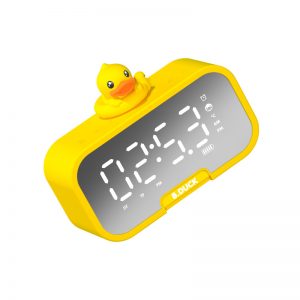The evolution of alarm clock speakers spans several decades and reflects the advancements in technology, design, and user preferences. Here’s a brief overview of the key stages in the evolution of alarm clock speakers:
- Early Mechanical Alarms (19th Century): The earliest alarm clocks were mechanical devices that used gears, springs, and bells to create loud ringing sounds at a preset time. These early alarms were basic and lacked the ability to play music or connect to external devices.
- Electromechanical Alarms (20th Century): With the advent of electricity, alarm clocks became more sophisticated. Electromechanical alarms integrated electrical components to trigger alarms and often included features like snooze buttons and adjustable alarm tones. These devices were primarily focused on the alarm function.
- Digital Displays (Late 20th Century): The introduction of digital displays brought numerical time displays to alarm clocks. This allowed for clearer and more precise time readings. Some alarm clocks included basic radio functionality, but they were still primarily alarm-focused devices.
- Integration of Radio (Late 20th Century): In the latter part of the 20th century, alarm clock radios became popular. These devices combined alarm functionality with the ability to play AM/FM radio stations. This allowed users to wake up to music or news broadcasts.
- CD and Cassette Integration (Late 20th Century): Some advanced alarm clock radios featured built-in CD players or cassette decks, enabling users to wake up to their favorite CDs or tapes. This marked the beginning of integrating audio playback into alarm clocks.
- Digital Audio Players (Early 2000s): As digital audio technology advanced, alarm clock speakers started integrating support for iPods and other MP3 players. Docking stations and connectors allowed users to wake up to their own music libraries.
- Bluetooth Connectivity (Mid 2010s): The rise of smartphones led to the integration of Bluetooth technology into alarm clock speakers. This allowed users to wirelessly connect their phones to the speakers for audio playback and even speakerphone functionality.
- Smart Features (Late 2010s): With the advent of smart home technology, alarm clock speakers began to incorporate features like voice control through virtual assistants like Amazon Alexa and Google Assistant. This allowed users to control their alarms, music, and even smart home devices using voice commands.
- Wireless Charging and App Integration (Recent Years): Modern alarm clock speakers often include wireless charging pads for smartphones and support for mobile apps. This further integrates the alarm clock speaker into users’ daily routines, allowing them to control alarms, customize settings, and access additional features through apps.
- High-Fidelity Audio and Design Diversity (Present): Current alarm clock speakers offer high-quality audio, improved sound technology, and a wide range of design options to suit various preferences and room aesthetics. Some models offer advanced sound processing and integration with streaming services.
The evolution of alarm clock speakers demonstrates a progression from basic mechanical alarms to sophisticated smart devices that combine alarm functionality with advanced audio playback, connectivity options, and smart features. This evolution has been driven by technological advancements and changing user expectations for convenience, versatility, and integration into modern lifestyles.












